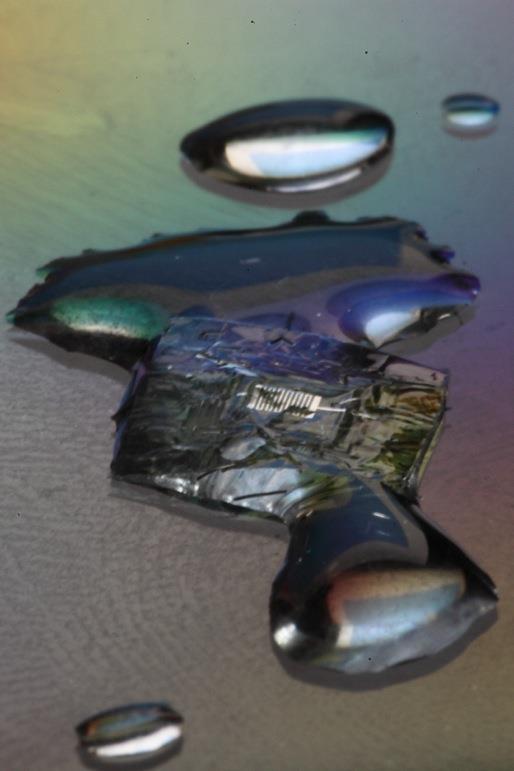

J.Rogers/UIUC
A new generation of transient electronic devices function in water but dissolve when their function is no longer needed.
Electronic devices that dissolve completely in water, leaving behind only harmless end products, are part of a rapidly emerging class of technology pioneered by researchers at the University of Illinois at Urbana-Champaign.
Early results demonstrate the entire complement of building blocks for integrated circuits, along with various sensors and actuators with relevance to clinical medicine, including most recently intracranial monitors for patients with traumatic brain injury.
The advances suggest a new era of devices that range from green consumer electronics to ‘electroceutical’ therapies, to biomedical sensor systems that do their work and then disappear.
John A. Rogers’ research group at the Department of Materials Science and Engineering Frederick Seitz Materials Research Laboratory is leading the development of such concepts, along with all of the required materials, device designs and fabrication techniques for applications that lie beyond the scope of semiconductor technologies that are available today.
“Our most recent combined developments in devices that address real challenges in clinical medicine and in advanced, high volume manufacturing strategies suggest a promising future for this new class of technology,” said Rogers. He will present these and other results at the AVS 61st International Symposium & Exhibition, being held November 9-14, 2014 in Baltimore, Md.
Practical applications might include: bioresorbable devices that reduce infection at a surgical site. Other examples are temporary implantable systems, such as electrical brain monitors to aid rehabilitation from traumatic injuries or electrical simulators to accelerate bone growth. Additional classes of devices can even be used for programmed drug delivery, Rogers said.
Such envisioned uses are all best satisfied by devices that provide robust, reliable, high performance operation, but only for a finite period of time dictated, for example, by the healing process—they are not only biologically compatible, but they are biologically punctual, performing when and as the body needs them.
After their function has been fulfilled, they disappear through resorption into the body, thereby eliminating unnecessary device load, without the need for additional surgical operations. In terms of consumer electronics, the technology holds promise for reducing the environmental footprint of the next generation of “green” devices.
MORE ABOUT THE AVS 61st INTERNATIONAL SYMPOSIUM & EXHIBITION
The symposium takes place from November 9-14 at the Baltimore Convention Center, which is located at One West Pratt Street in Baltimore, Maryland, 21201. The headquarters hotel is the Sheraton Inner Harbor at 300 South Charles Street in Baltimore, Maryland, 21201.
USEFUL LINKS
Main symposium website: http://www.avs.org/Meetings-Exhibits/Information
Technical Program: http://www.avssymposium.org
Media Center: https://www.avs.org/About/Press-Media-Center
Baltimore Convention Center: http://www.bccenter.org
Sheraton Inner Harbor: https://www.marriott.com/hotels/travel/bwiis-sheraton-inner-harbor-hotel/
PRESSROOM
The AVS Pressroom will be located in the Charles Street Lobby Staff Office of the Baltimore Convention Center. Pressroom hours are Monday-Thursday, 8:00 a.m. – 5:00 p.m. Your press badge will allow you to utilize the pressroom to write, interview, collect new product releases, review material, or just relax. The press badge will also admit you, free of charge, into the exhibit area, lectures, and technical sessions, as well as the Welcome Mixer at 5:30 p.m. ET on Monday in Ballroom III of the Baltimore Convention Center and the Awards Ceremony and Reception at 6:30 p.m. ET on Wednesday night in Ballroom I-II of the Baltimore Convention Center.
To request free press registration, please contact Jason Socrates Bardi: jbardi@aip.org and Della Miller della@avs.org
ABOUT AVS
Founded in 1953, AVS is a not-for-profit professional society that promotes communication between academia, government laboratories, and industry for the purpose of sharing research and development findings over a broad range of technologically relevant topics. Its symposia and journals provide an important forum for the dissemination of information in many areas of science and technology, enabling a critical gateway for the rapid insertion of scientific breakthroughs into manufacturing realities. See: http://www.avs.org/About
Contact Information
Jason Socrates Bardi
American Institute of Physics
jbardi@aip.org
240-535-4954
@jasonbardi












